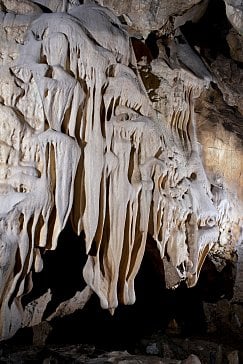THE NA POMEZÍ CAVES: UNDERGROUND BEAUTY FORMED IN MARBLE IS HOME TO RARE SPECIES OF BATS.

The Na Pomezí caves are the largest accessible cave system in the Czech Republic, formed by dissolving marble. Take a look there with our leading speleologist Petr Zajíček.
The northernmost outcrop of Moravia is filled by the Rychlebské hory ridge. The mountain range is an imaginary continuation of the Hrubý Jeseník massif. The Rychleby karst areas are bound to isolated islands of marble, which were formed by the gradual recrystallization of limestone.
Dozens of surface and underground karst phenomena are recorded here, the most important of which is the Na Pomezí cave system. It is the longest cave created in marble (also crystalline limestone).

The Marble Kingdom
Its entrance is located in a former quarry under the Na Pomezí saddle between Lipová-Lázně and Vápenná. More extensive caves in this locality were unknown to people for a long time. However, during marble mining, cave cavities or fissures were often found. In 1936, after blasting the stone, a cave leading to a depth of 60 metres was discovered. Today it is called Rasovna and is genetically related to Na Pomezí Cave, although the two caves were not physically connected.
A year later, the first people also penetrated the premises of the Na Pomezí cave, but there is no written record of this. It was only after the Second World War that speleological activities were started in the area by a group of researchers from the tourist department of the Jeseník Sokol. They managed to penetrate and then explore a substantial part of the Na Pomezí cave system on 28 August 1949.
In one of the rooms near the surface, they discovered an inscription by Kurt Höhle dated 21 October 1937, which proves that the quarry workers had entered the Na Pomezí cave twelve years earlier. In May 1950, a part of the area was opened to the public and in 1955, after the entrance and exit tunnels were broken through, the Na Pomezí cave was opened in a complete circuit.
The new discovery
The majority of the Na Pomezí Cave is of a fissure nature. Long, high passages are interspersed with more spacious domes created at the intersection of fissures. The two-storey cave system was formed by the gradual corrosive action of atmospheric waters with the participation of underground flow. Frost destruction during the Quaternary ice ages also contributed to the formation of the spaces.
The Na Pomezí cave has rich stalactite decoration. The most typical forms are cascading sinter flows covering the walls of the passages, as well as sinter dykes, stalactites, stalagmites and translucent curtains. In 2008, amateur speleologists made a unique discovery in the nearby Fox Hole. Not only did they connect this cave with the Na Pomezí cave, but they also discovered the largest dome of this system, measuring 40 x 20 x 15 metres.


The most beautiful underwater caves in the world – a beauty you won’t see just like this
Currently, the Na Pomezí – Foxhole cave system is 1,760 metres long with a height range of 47 metres. The sightseeing circuit is 390 metres long. Na Pomezí Cave is an important wintering ground for bats and wrens.
Source: National Geographic
Author: Petr Zajíček | Published: 14.09.2012
